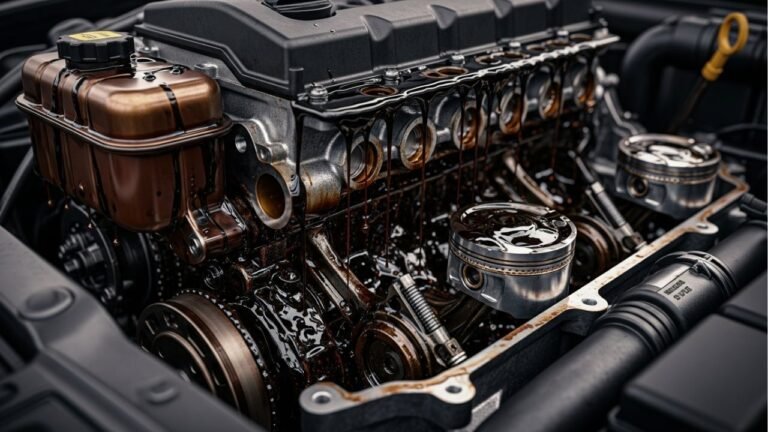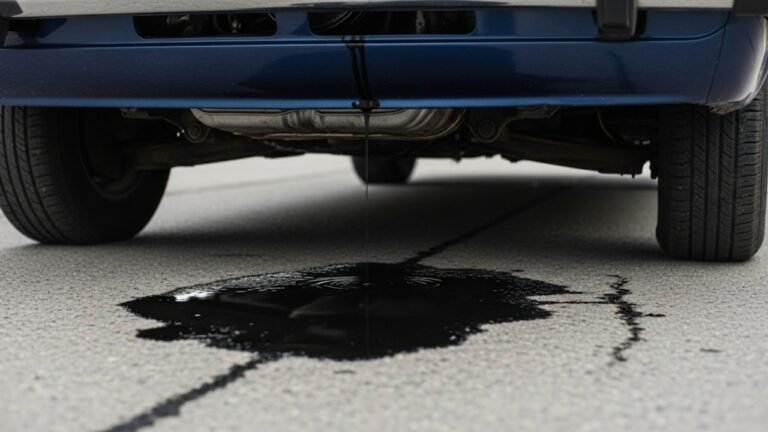What If You Put Too Much Oil in Your Car?

Imagine you’re topping up your engine oil on a lazy Sunday afternoon. The sun’s shining, the birds are chirping, and you’re feeling productive. You unscrew the cap, pour the oil in, and… maybe just a little more for good measure. But suddenly, you’ve gone past the recommended mark. You start wondering—what if you put too much oil in your car?
It’s a common mistake, especially for first-time car owners. It might seem harmless, but overfilling your engine oil can cause a surprising amount of damage. Think of it like overwatering a plant. A little extra water won’t kill it immediately, but give it time and you’ll see withered leaves and soggy roots.
In this article, we’ll explore:
-
The science of too much engine oil
-
What symptoms your car shows when it’s overfilled
-
Short-term and long-term damages
-
Easy ways to fix the issue
-
And how to avoid it next time
All explained in a way that’s clear, relatable, and straight from real-life experiences.
In This Article
- 1 Why Engine Oil Matters More Than You Think
- 2 How Much Is Too Much? Understanding the Limits
- 3 Real-Life Signs You’ve Overfilled Engine Oil
- 4 What Happens Inside the Engine When You Overfill?
- 5 How to Fix Overfilled Engine Oil: Step-by-Step
- 6 Long-Term Risks of Driving With Too Much Oil
- 7 How to Prevent Overfilling Oil in the First Place
- 8 Best Practices for Checking Your Oil Level
- 9 A Real-Life Story: How I Learned the Hard Way
- 10 Busting Common Myths About Overfilled Engine Oil
- 11 FAQs About Too Much Oil in a Car
- 11.1 1. How much is too much oil in a car?
- 11.2 2. Can I drive short distances with overfilled oil?
- 11.3 3. Will too much oil damage the engine permanently?
- 11.4 4. Can a mechanic fix this easily?
- 11.5 5. What should I do immediately after overfilling?
- 11.6 6. Can too much oil cause rough idling or misfires?
- 11.7 7. How do I know I fixed it correctly?
- 11.8 8. Is overfilling oil covered under warranty?
- 12 Final Thoughts: A Small Error, A Big Lesson
Why Engine Oil Matters More Than You Think
Engine oil is like the blood of your car. It keeps the engine running smooth, reducing friction and preventing parts from wearing out. But just like blood pressure, there’s a sweet spot. Not too low, not too high.
Too little oil leads to metal grinding on metal. But what if you put too much oil in your car? Then you’ve got another kind of problem—foamy oil, crankshaft resistance, and pressure buildup. In short, your car begins to struggle, and you might not even know why until it’s too late.
Let’s break down why oil overfill is such a serious problem:
-
It increases oil pressure unnaturally.
-
Causes seals and gaskets to leak.
-
Leads to aeration—when oil mixes with air and loses its lubricating power.
-
Can damage catalytic converters and oxygen sensors.
-
Might even blow your engine if ignored too long.
You wouldn’t pour soda into a laptop. Don’t flood your engine with oil either.
How Much Is Too Much? Understanding the Limits
Each car has an oil capacity, usually found in your owner’s manual. It’s typically between 4 to 6 quarts for most sedans. But if you accidentally add more than half a quart over the recommended level, you’re entering the danger zone.
Let’s make it clear with a table:
| Car Type | Average Oil Capacity | Overfill Risk Zone |
|---|---|---|
| Sedan | 4.5 quarts | Over 5.0 quarts |
| SUV | 5.5 quarts | Over 6.0 quarts |
| Truck | 6.0-7.5 quarts | Over 8.0 quarts |
So, what if you put too much oil in your car—say, by 1 quart? That’s more than enough to cause internal pressure build-up, which can break seals and force oil into the combustion chamber. That’s not just a mess—it’s a repair bill.
Real-Life Signs You’ve Overfilled Engine Oil
You don’t need to be a mechanic to know something’s wrong. Your car usually talks to you—you just need to listen.
Here are a few red flags:
1. Blue or White Exhaust Smoke
This is one of the most obvious signs. Too much oil can seep into the combustion chamber and burn off with the fuel, causing thick, white or blue smoke. It smells weird too—kind of burnt and sweet.
2. Smell of Burning Oil
Ever cooked oil on high heat? That smell is unmistakable. If you smell it near your engine, it might be oil hitting hot parts, like the exhaust manifold. It’s dangerous—could even start a fire.
3. Oil Leaks or Puddles
More oil means more pressure. The seals that keep your engine oil-tight can start leaking. You might notice puddles under your car or oil streaks along the engine.
4. High Oil Pressure on the Dashboard
If your oil pressure light comes on, or you notice weird gauge behavior, it might be due to overfill. High pressure isn’t always good—it means your oil isn’t flowing properly.
5. Rough Running Engine or Stalling
Too much oil makes it harder for the crankshaft to rotate freely. That resistance leads to poor performance—jerky starts, engine knocking, even sudden stalling at traffic lights.
So, what if you put too much oil in your car and then ignored these signs? You might be shortening your engine’s lifespan by months—or years.
What Happens Inside the Engine When You Overfill?
Let’s go under the hood for a moment. When oil is at the proper level, it sits below the crankshaft. But too much oil rises and submerges the crankshaft.
Now picture this: the crankshaft spinning at thousands of RPMs, whipping the oil like a blender. This creates foam—air bubbles in the oil. Foam doesn’t lubricate well. It also raises the temperature of your engine and reduces oil pressure.
Here’s what happens step-by-step:
-
Oil reaches crankshaft and gets churned.
-
Aerated oil can’t flow smoothly, leading to inconsistent lubrication.
-
Heat builds up, increasing wear on engine parts.
-
Seals and gaskets weaken and start leaking oil.
-
Catalytic converter gets contaminated, reducing fuel efficiency.
It’s like flooding your bathroom sink. Water spills everywhere. Everything is wet, messy, and out of control.
How to Fix Overfilled Engine Oil: Step-by-Step
So you’ve realized—oops! You’ve added too much oil. Don’t panic. Fixing it is easier than you think.
1. Confirm the Overfill
-
Pull out the dipstick.
-
Wipe it clean.
-
Reinsert fully, then pull it out again.
-
Check the oil level. If it’s over the “MAX” mark, you’ve overfilled.
2. Choose a Drain Method
There are two main ways to fix this:
Option A: Use an Oil Extractor Pump
-
Insert the extractor tube down the dipstick tube.
-
Pump out small amounts gradually.
-
Recheck the dipstick level every few minutes.
Option B: Drain from the Oil Plug
-
Place a pan under the oil pan.
-
Loosen the drain plug just slightly.
-
Let a small amount drain out.
-
Tighten back and recheck dipstick.
3. Dispose of Excess Oil Properly
Never pour oil down a drain or into the soil. Take it to a recycling center or auto shop.
4. Recheck Symptoms
After correcting the oil level:
-
Check for leaks or smells.
-
Drive a short distance.
-
Make sure everything feels normal again.
What if you put too much oil in your car and didn’t catch it in time? You may need a mechanic’s help to check for internal damage.
Long-Term Risks of Driving With Too Much Oil
You might think, “Well, I’ve been driving it for a few days and nothing exploded.” But some damage isn’t immediate. Internal parts wear out slowly.
Here’s what can go wrong in the long run:
-
Blown head gasket – a costly repair.
-
Fouled spark plugs, reducing power and mileage.
-
Ruined catalytic converter, affecting emissions and performance.
-
Bent connecting rods, if oil pressure causes hydrolocking.
-
Engine failure, if ignored for weeks.
In fact, insurance usually won’t cover engine damage due to overfill—it’s considered owner negligence. You don’t want to be in that spot.
How to Prevent Overfilling Oil in the First Place
Prevention is easier—and cheaper—than fixing problems later. If you’re topping up oil at home, it’s easy to get excited and pour too much. But just like cooking, eyeballing it doesn’t always work.
Here are some solid tips to prevent overfilling engine oil:
-
Always check the manual. Your owner’s manual will tell you the exact oil capacity in quarts or liters. Never guess.
-
Use a funnel. This helps you pour slowly and accurately without spillage.
-
Add oil little by little. Start with half a quart, then check the dipstick before adding more.
-
Check when the engine is cold. Oil expands when hot. For a true reading, let the engine sit for 10–15 minutes.
-
Use transparent bottles with level markers. This helps track exactly how much you’ve poured.
And remember: what if you put too much oil in your car? That “just a bit more” approach can cause hundreds in repair costs.
Best Practices for Checking Your Oil Level
Your dipstick is your best friend. Seriously, it tells you more than you think. Make a habit of checking oil every few weeks or before long road trips.
Here’s a simple method:
-
Park your car on level ground.
-
Let the engine cool down for 10–20 minutes.
-
Pull the dipstick out and wipe it clean.
-
Reinsert it fully and pull it out again.
-
Look for oil between the “MIN” and “MAX” lines.
If you see oil well above the “MAX” mark, now you know what that means—too much oil in your car, and it needs fixing.
A Real-Life Story: How I Learned the Hard Way
Let me share something personal. A few years ago, I had just bought my first used car—a Honda Civic. I was so proud. I read online that regular oil checks were important, so I tried topping it up.
But I didn’t read the manual. I didn’t measure. I just poured in half a bottle and called it a day.
The next morning, I noticed white smoke from the exhaust and a weird burning smell. At first, I thought it was just old oil. Then the engine light came on.
Long story short—I had overfilled by more than a quart. I ended up at the mechanic, who drained the oil, cleaned the spark plugs, and charged me $120. Not terrible, but completely avoidable.
Ever since then, I’ve learned: when it comes to car oil, more isn’t better—right is better.
Busting Common Myths About Overfilled Engine Oil
There’s a lot of misinformation floating around. Let’s clear up some of the biggest myths.
| Myth | Truth |
|---|---|
| A little extra oil won’t hurt. | Even a small overfill can cause foaming and damage. |
| It’s better to overfill than underfill. | Both are bad. Balance is key. |
| My engine light would warn me. | Not always. Some cars don’t have overfill sensors. |
| Thick oil means better protection. | Not if it’s too much. It can cause overheating and internal resistance. |
So next time someone says, “Don’t worry about it,” remember: what if you put too much oil in your car is not a “what-if” you want to test in real life.
FAQs About Too Much Oil in a Car
1. How much is too much oil in a car?
Anything more than ½ quart above the full mark is too much. It varies by engine, but even that small amount can cause damage over time.
2. Can I drive short distances with overfilled oil?
You can, but you shouldn’t. Short trips might not show immediate problems, but it increases wear each time you start the engine.
3. Will too much oil damage the engine permanently?
If left unchecked, yes. Prolonged overfilling can destroy gaskets, foul spark plugs, and even ruin your catalytic converter.
4. Can a mechanic fix this easily?
Yes. Draining excess oil is simple. The real issue is if the engine has already suffered damage.
5. What should I do immediately after overfilling?
Turn off the engine, wait for it to cool, check the dipstick, and remove oil if needed. Don’t drive until it’s fixed.
6. Can too much oil cause rough idling or misfires?
Absolutely. Oil in the combustion chamber disrupts the firing process, leading to jerking, rough idling, or poor acceleration.
7. How do I know I fixed it correctly?
Once the oil level is back between the marks and the car runs smooth without smell, smoke, or leaks—you’re good to go.
8. Is overfilling oil covered under warranty?
Usually not. It’s considered operator error. Most warranties exclude damage caused by maintenance mistakes.
Final Thoughts: A Small Error, A Big Lesson
Let’s be honest—we all mess up. Maybe you were in a hurry. Maybe you just didn’t know. But now that you’ve asked what if you put too much oil in your car, you’ve taken the first step toward being a better car owner.
Think of engine oil like your body’s hydration. Too little, and you’re sluggish. Too much, and you’re bloated and off-balance. Your car’s the same. Treat it gently, feed it right, and it’ll take care of you for years to come.
So the next time you’re under the hood, take a deep breath, read the dipstick, and remember: less guesswork, more precision. Your engine will thank you.






